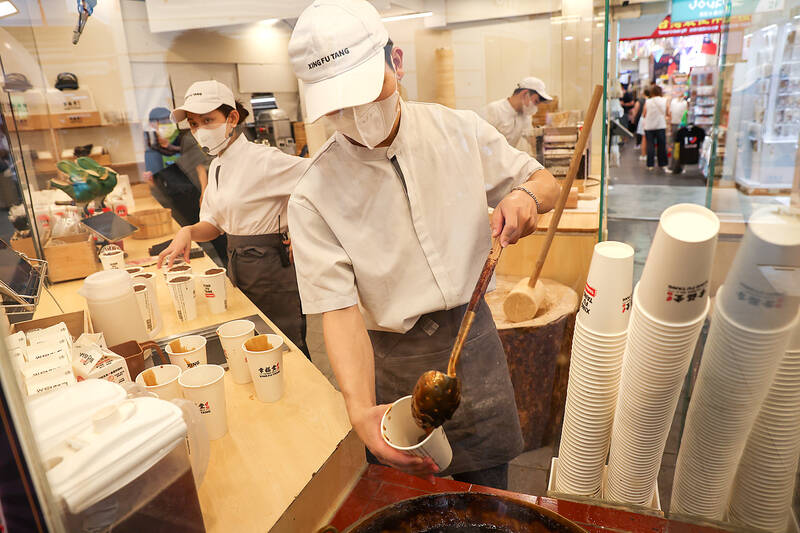The unemployment rate last month edged down to 3.36 percent, slipping 0.02 percentage points from September and marking the lowest level in 25 years, as the impact of the graduation season faded, the Directorate-General of Budget, Accounting and Statistics (DGBAS) said yesterday.
After seasonal adjustments, joblessness stood at 3.33 percent, easing by 0.02 percentage points.
Total unemployment was down 3,000 from September to 404,000, largely aided by a drop in first-time jobseekers, as more graduates secured employment, DGBAS Census Department Deputy Director Tan Wen-ling (譚文玲) said.

Photo: CNA
Overall employment increased to 11.64 million, up 5,000 from the prior month, Tan said.
The service sector generated most of the gains, adding 9,000 jobs, while industrial sectors shed about 1,000 positions as global demand remained uneven, she said.
The number of underemployed workers — a measure closely watched, because it often reflects unpaid leave or reduced working hours — also declined, Tan said.
Underemployment fell to 126,000, a retreat of 3,000 in September, she said.
Underemployed workers are defined as people whose weekly working hours fall below 35 due to economic factors, but who remain available and are willing to work more.
The indicator climbed from July and peaked at 129,000 in September, the highest level this year, before easing last month.
“The decline suggests that furlough programs tied to US reciprocal tariff pressures have largely stabilized,” Tan said, adding that the weaker New Taiwan dollar over the past few weeks also offered some support to employers.
Youth unemployment remained noticeably higher than the national average, with the jobless rate for people aged 20 to 24 at 11.81 percent, reflecting the adjustment period typically faced by first-time jobseekers.
The unemployment rate for those aged 25 to 29 was 5.78 percent, while joblessness among workers aged 30 to 34 was 3.22 percent, showing a more stable environment for mid-career employees.
A trend is emerging in the labor force participation of people aged 35 to 39 — a key segment of the prime working-age population: Participation in this group fell to 92.38 percent last month, down from 93.12 percent in January and nearly one percentage point lower than a year earlier.
The decline is visible, but not yet concerning, Tan said, adding that demographic factors, particularly declining birthrates, might be influencing workforce participation patterns.
Unemployment was highest among university graduates at 4.55 percent, followed by those with graduate degrees at 3.08 percent and high-school diploma holders at 3.01 percent. People with a junior-high education or below had the lowest jobless rate at 2.11 percent.

Shiina Ito has had fewer Chinese customers at her Tokyo jewelry shop since Beijing issued a travel warning in the wake of a diplomatic spat, but she said she was not concerned. A souring of Tokyo-Beijing relations this month, following remarks by Japanese Prime Minister Sanae Takaichi about Taiwan, has fueled concerns about the impact on the ritzy boutiques, noodle joints and hotels where holidaymakers spend their cash. However, businesses in Tokyo largely shrugged off any anxiety. “Since there are fewer Chinese customers, it’s become a bit easier for Japanese shoppers to visit, so our sales haven’t really dropped,” Ito

The number of Taiwanese working in the US rose to a record high of 137,000 last year, driven largely by Taiwan Semiconductor Manufacturing Co’s (TSMC, 台積電) rapid overseas expansion, according to government data released yesterday. A total of 666,000 Taiwanese nationals were employed abroad last year, an increase of 45,000 from 2023 and the highest level since the COVID-19 pandemic, data from the Directorate-General of Budget, Accounting and Statistics (DGBAS) showed. Overseas employment had steadily increased between 2009 and 2019, peaking at 739,000, before plunging to 319,000 in 2021 amid US-China trade tensions, global supply chain shifts, reshoring by Taiwanese companies and

Taiwan Semiconductor Manufacturing Co (TSMC, 台積電) received about NT$147 billion (US$4.71 billion) in subsidies from the US, Japanese, German and Chinese governments over the past two years for its global expansion. Financial data compiled by the world’s largest contract chipmaker showed the company secured NT$4.77 billion in subsidies from the governments in the third quarter, bringing the total for the first three quarters of the year to about NT$71.9 billion. Along with the NT$75.16 billion in financial aid TSMC received last year, the chipmaker obtained NT$147 billion in subsidies in almost two years, the data showed. The subsidies received by its subsidiaries —

Taiwan Semiconductor Manufacturing Co (TSMC) Chairman C.C. Wei (魏哲家) and the company’s former chairman, Mark Liu (劉德音), both received the Robert N. Noyce Award -- the semiconductor industry’s highest honor -- in San Jose, California, on Thursday (local time). Speaking at the award event, Liu, who retired last year, expressed gratitude to his wife, his dissertation advisor at the University of California, Berkeley, his supervisors at AT&T Bell Laboratories -- where he worked on optical fiber communication systems before joining TSMC, TSMC partners, and industry colleagues. Liu said that working alongside TSMC